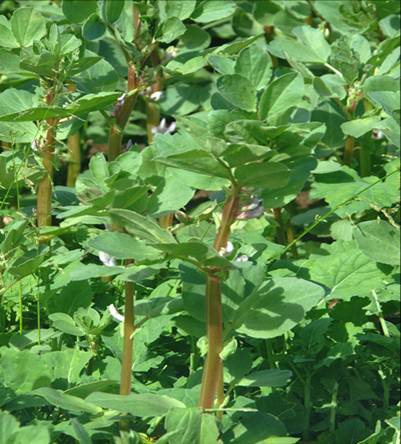
With the increased area for beans in the ground plus fewer pulse herbicides now available due to registration issues, there could well be more crops that will require a post-emergence herbicide this year, says BASF.
"Peas and beans suffer heavily from weed competition during their early stages of growth and early weed removal is essential to protect yield and quality. This year because of the higher prices of the end-produce, more beans were drilled than anticipated and although pre-emergence herbicides such as Nirvana were applied on a fair proportion, there are still crops which haven't been treated as yet and this is where Basagran SG comes in," says Jonathan Ball, BASF Pulse Product Manager.
Jonathan explains that Basagran SG (bentazone) is a one of the rare post-emergence herbicide options in beans and peas. "Unfortunately UK growers have lost the use of a number of good and effective herbicides in peas and beans recently. Simazine, Reflex T (terbutryn + fomesafen), Opogard/Battalion (terbutryn + terbuthylazine), Fortrol (cyanazine) and Bullet (cyanazine + pendimethalin) are no longer available. The loss of Fortrol has had a knock-on effect on the popular post-emergence pea herbicides of Pulsar (bentazone + MCPB) and Trifolex-Tra (MCPB + MCPA), as their use was dependent on the addition of cyanazine."
"Post-emergence options for broad-leaved weed control in winter field beans, spring beans and broad beans remain solely with Basagran SG. It is also recommended in vining and combining peas as one of the true post-emergence products, applied from the third node onwards."
"Basagran SG offers good flexibility, particularly when there is a need for late or follow-up control of difficult weeds such as Cleavers or Black Nightshade. It also gives good control of Volunteer rape, Charlock, Chickweed, Fools Parsley, Redshank, Shepherd's-purse and Small Nettle. If you need to boost the control of Black-bindweed, Fat-hen, Fumitory and Orache, you have the option of adding MCPB to Basagran SG," says Jonathan Ball.
Simon Francis, Agronomy Manager for BASF, points out that growers must make sure that Basagran SG is allowed to work to its best effect. "Optimum performance from Basagran will be achieved when target weeds are small and are growing actively at the time of spraying. Water volumes, pressures and nozzle types should be selected to ensure good coverage of the leaves and growing points of the weeds. Basagran SG also favours bright sunlight, adequate soil moisture and warm conditions."
However if it becomes too warm and temperatures rise above 21˚C, crop selectivity may be reduced and so Simon advises under these circumstances to delay the application until the temperatures decline in the late afternoon or evening. "When applying a contact herbicide post-emergence, growers should make sure that the crop has adequate wax levels, by using a Crystal Violet test. Wax levels vary depending on the variety and weather, with wind, rain and frost all having an adverse effect."
"Furthermore also ensure varietal tolerances are checked before spraying." Further information can be found at www.agriCentre.basf.co.uk or by contacting your local BASF Agronomy Manager or the BASF Technical Services Hotline.
Simon also points out that by growing spring-sown pulses, growers give themselves another opportunity to control difficult grass-weeds on the farm. "Aramo (tepraloxydim) in particular continues to be useful in programmes to manage difficult black-grass across the rotation and will also give good control of Annual Meadow-grass, Wild-oats and Volunteer cereals."
For further comment and information please contact:
1) Jonathan Ball, BASF on 0161 488 5785 or on his mobile 0771 7782768
2) Simon Francis, BASF on 01943 604206 or on his mobile 07831 262325
